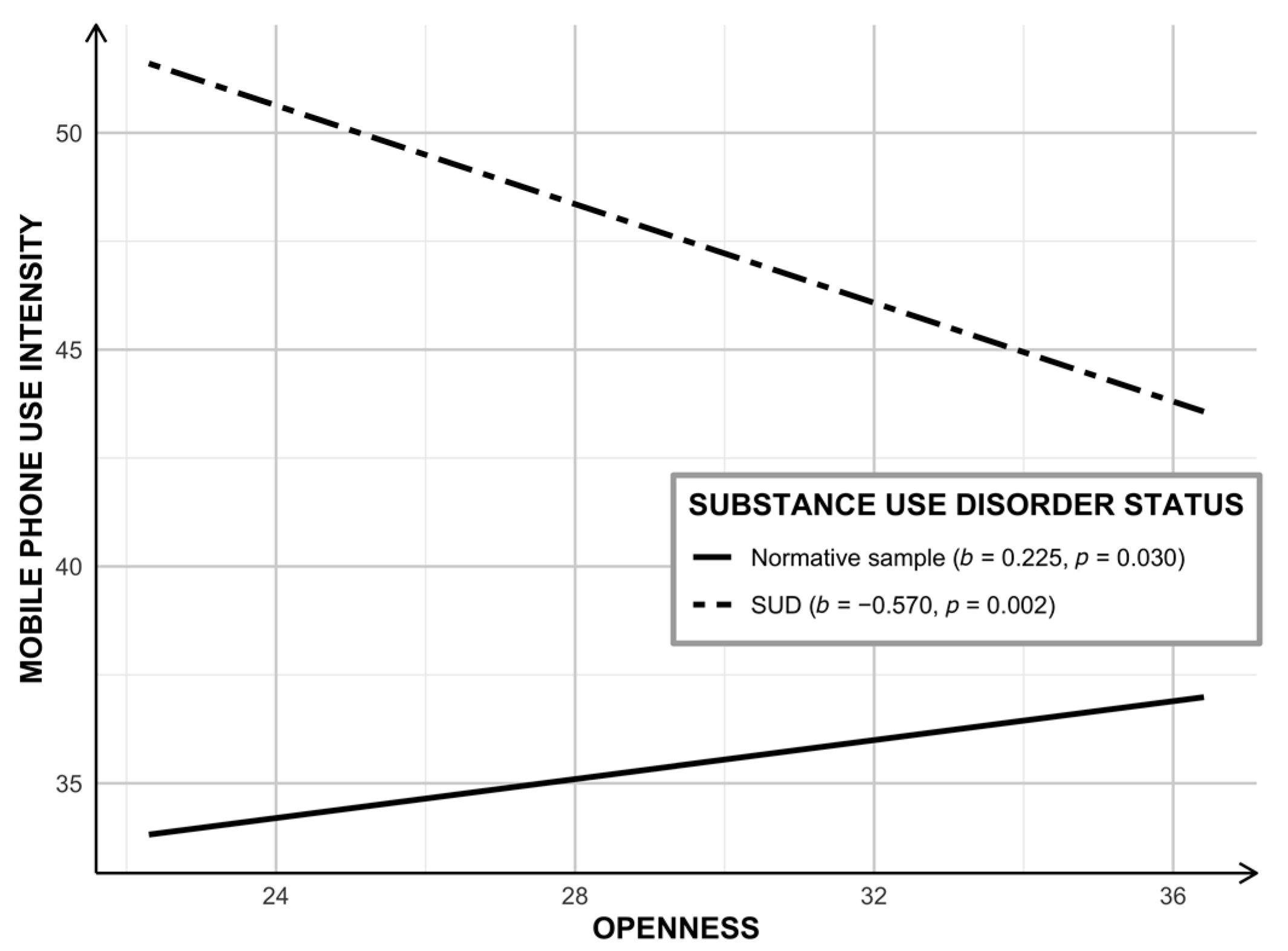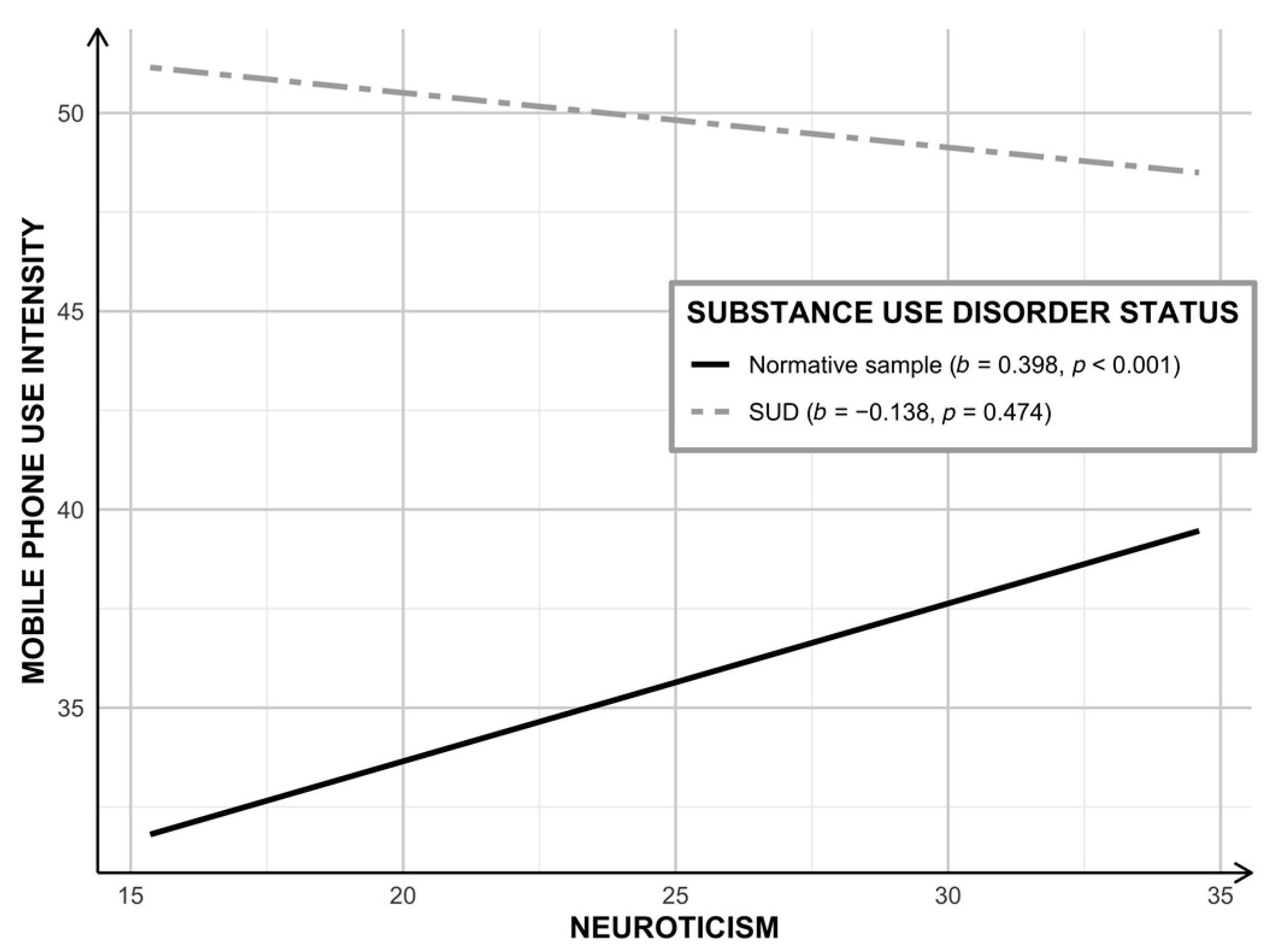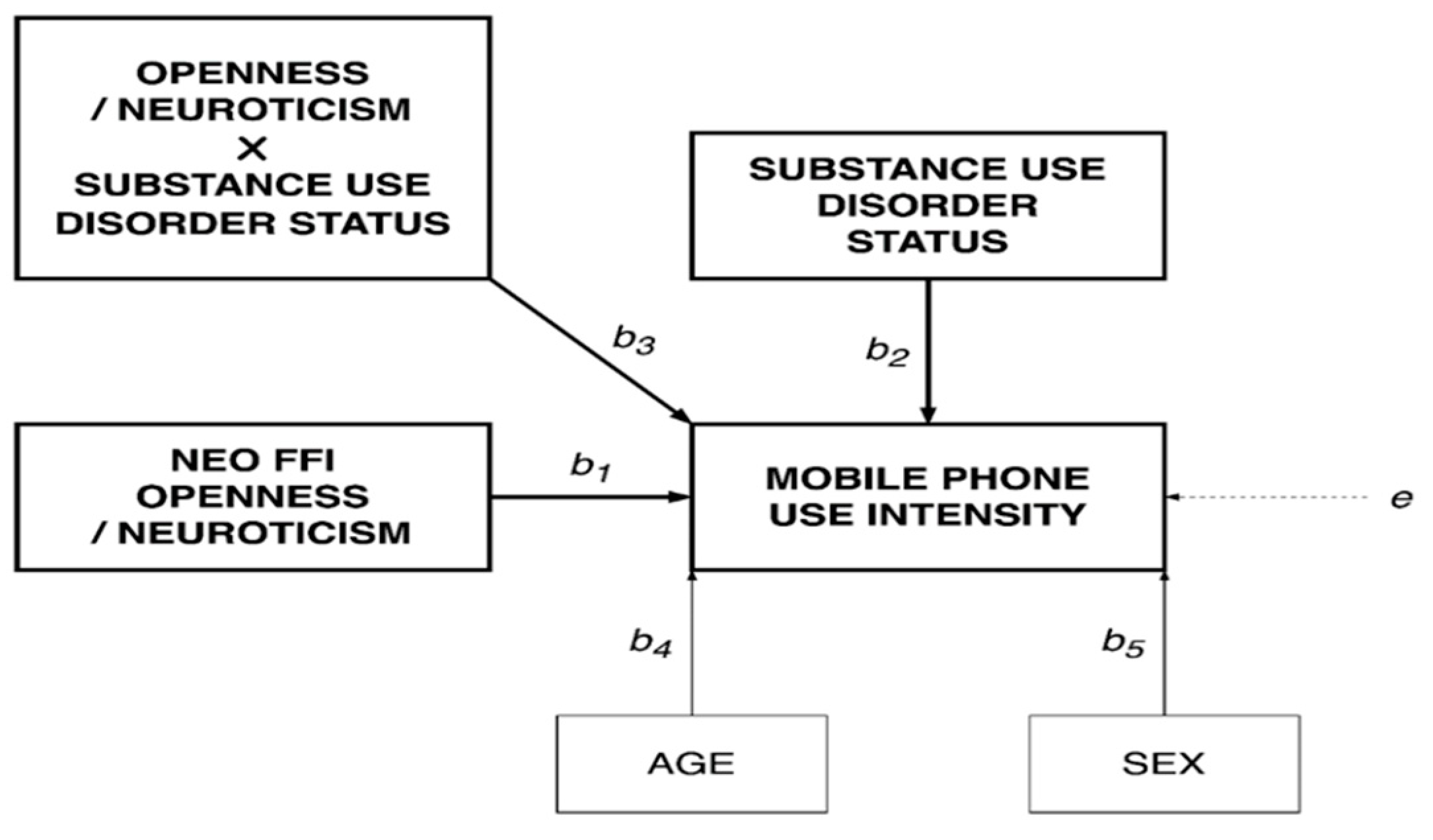Substance Use Disorder Status Moderates the Association between Personality Traits and Problematic Mobile Phone/Internet Use
Abstract
1. Introduction
2. Material and Methods
2.1. Procedures
2.2. Participants
2.3. Measures
2.3.1. Problematic Mobile Phone Use
2.3.2. Internet Addiction
2.3.3. Personality Traits
2.3.4. Substance Use Disorder
2.4. Data Analysis
3. Results
3.1. Moderation Models
3.1.1. Model A: Openness to Experiences, SUD Status, and Smartphone Use Intensity
3.1.2. Model B: Neuroticism, SUD Status, and Smartphone Use Intensity
3.2. Additional Analyses
4. Discussion
4.1. Neuroticism
4.2. Openness to New Experiences
4.3. Extraversion, Agreeableness, Conscientiousness
4.4. Limitations
5. Conclusions
Author Contributions
Funding
Institutional Review Board Statement
Informed Consent Statement
Data Availability Statement
Conflicts of Interest
References
- Kemp, S. Digital Trends 2019: Every Single Stat You Need to Know about the Internet. Available online: https://thenextweb.com/contributors/2019/01/30/digital-trends-2019-every-single-stat-you-need-to-know-about-the-internet/ (accessed on 12 January 2021).
- Kabali, H.K.; Irigoyen, M.M.; Nunez-Davis, R.; Budacki, J.G.; Mohanty, S.H.; Leister, K.P.; Bonner, R.L. Exposure and use of mobile media devices by young children. Pediatrics 2015, 136, 1044–1050. [Google Scholar] [CrossRef] [PubMed]
- Bąk, A. Jak małe dzieci korzystają z urządzeń mobilnych? Raport na podstawie danych zebranych od rodziców. Dziecko Krzywdzone. Teoria Bad. Prakt. 2015, 14, 55–82. [Google Scholar]
- Aggarwal, K. Twenty-six percent doctors suffer from severe mobile phone-induced anxiety: Excessive use of mobile phone can be injurious to your health. Indian J. Clin. Pract. 2013, 24, 7–9. [Google Scholar]
- Ali, M.; Asim, M.; Danish, S.H.; Ahmad, F.; Iqbal, A.; Hasan, S.D. Frequency of De Quervain’s tenosynovitis and its association with SMS texting. Muscles Ligaments Tendons J. 2014, 4, 74–78. [Google Scholar] [CrossRef]
- Ha, J.H.; Chin, B.; Park, D.H.; Ryu, S.H.; Yu, J. Characteristics of excessive cellular phone use in Korean adolescents. Cyberpsychol. Behav. Impact Internet Multimed. Virtual Real. Behav. Soc. 2008, 11, 783–784. [Google Scholar] [CrossRef]
- Sahin, S.; Ozdemir, K.; Unsal, A.; Temiz, N. Evaluation of mobile phone addiction level and sleep quality in university students. Pak. J. Med Sci. 2013, 29, 913. [Google Scholar] [CrossRef]
- Verma, R.K.; Rajiah, K.; Cheang, A.; Barua, A. Textaphrenia: An emerging silent pandemic. Afr. J. Psychiatry 2014, 17, 510–511. [Google Scholar]
- Alavi, S.S.; Ferdosi, M.; Jannatifard, F.; Eslami, M.; Alaghemandan, H.; Setare, M. Behavioral addiction versus substance addiction: Correspondence of psychiatric and psychological views. Int. J. Prev. Med. 2012, 3, 290. [Google Scholar]
- Billieux, J.; Maurage, P.; Lopez-Fernandez, O.; Kuss, D.J.; Griffiths, M.D. Can disordered mobile phone use be considered a behavioral addiction? An update on current evidence and a comprehensive model for future research. Curr. Addict. Rep. 2015, 2, 156–162. [Google Scholar] [CrossRef]
- Hussain, Z.; Pontes, H. Personality, internet addiction, and other technological addictions: An update of the research literature. In Multifaceted Approach to Digital Addiction and Its Treatment; IGI Global: Hershey, PA, USA, 2019; pp. 46–72. [Google Scholar] [CrossRef]
- Costa, P.T., Jr. Revised NEO personality inventory and NEO five-factor inventory. Psychol. Assess. Resour. 1992. [Google Scholar]
- Takao, M. Problematic mobile phone use and big-five personality domains. Indian J. Community Med. Off. Publ. Indian Assoc. Prev. Soc. Med. 2014, 39, 111. [Google Scholar] [CrossRef]
- Bianchi, A.; Phillips, J.G. Psychological predictors of problem mobile phone use. Cyberpsychol. Behav. Impact Internet Multimed. Virtual Real. Behav. Soc. 2005, 8, 39–51. [Google Scholar] [CrossRef]
- Lachmann, B.; Duke, É.; Sariyska, R.; Montag, C. Who’s addicted to the smartphone and/or the Internet? Psychol. Pop. Media Cult. 2019, 8, 182–189. [Google Scholar] [CrossRef]
- Gao, L.; Zhai, S.; Xie, H.; Liu, Q.; Niu, G.; Zhou, Z. Big five personality traits and problematic mobile phone use: A meta-analytic review. Curr. Psychol. 2020. [Google Scholar] [CrossRef]
- Comings, D.E.; Gade-Andavolu, R.; Gonzalez, N.; Wu, S.; Muhleman, D.; Chen, C.; Koh, P.; Farwell, K.; Blake, H.; Dietz, G.; et al. The additive effect of neurotransmitter genes in pathological gambling. Clin. Genet. 2001, 60, 107–116. [Google Scholar] [CrossRef]
- Leeman, R.F.; Potenza, M.N. A targeted review of the neurobiology and genetics of behavioural addictions: An emerging area of research. Can. J. Psychiatry Rev. Can. Psychiatr. 2013, 58, 260–273. [Google Scholar] [CrossRef]
- Krzyżak-Szymańska, E. Uzależnienia Technologiczne Wśród Dzieci i Młodzieży. Teoria, Profilaktyka, Terapia–Wybrane Zagadnienia; Impuls: Kraków, Poland, 2018. [Google Scholar]
- Dalkner, N.; Unterrainer, H.-F.; Neubauer, A. Differences in big five personality traits between alcohol and polydrug abusers: Implications for treatment in the therapeutic community. Int. J. Ment. Health Addict. 2013, 11. [Google Scholar] [CrossRef]
- Dey, M.; Studer, J.; Schaub, M.P.; Gmel, G.; Ebert, D.D.; Lee, J.Y.; Haug, S. Problematic smartphone use in young Swiss men: Its association with problematic substance use and risk factors derived from the pathway model. J. Behav. Addict. 2019, 8, 326–334. [Google Scholar] [CrossRef]
- Terracciano, A.; Löckenhoff, C.E.; Crum, R.M.; Bienvenu, O.J.; Costa, P.T. Five-Factor Model personality profiles of drug users. BMC Psychiatry 2008, 8, 22. [Google Scholar] [CrossRef] [PubMed]
- Klimkiewicz, A.; Demkow, M.; Jakubczyk, A.; Mach, A.; Abramowska, M.; Szczypiński, J.; Wnorowska, A.; Wojnar, M. Używanie telefonów komórkowych i internetu przez osoby uzależnione od substancji psychoaktywnych, pacjentów z zaburzeniami psychicznymi oraz studentów. Psychiatria 2019, 16, 59–66. [Google Scholar]
- Zilberman, N.; Yadid, G.; Efrati, Y.; Neumark, Y.; Rassovsky, Y. Personality profiles of substance and behavioral addictions. Addict. Behav. 2018, 82, 174–181. [Google Scholar] [CrossRef] [PubMed]
- Pużyński, S.; Wciórka, J. Klasyfikacja Zaburzeń Psychicznych i Zaburzeń Zachowania w ICD-10; Uniwersyteckie Wydawnictwo Medyczne: Warszawa, Poland, 2000. [Google Scholar]
- Mach, A.; Demkow-Jania, M.; Klimkiewicz, A.; Jakubczyk, A.; Abramowska, M.; Kuciak, A.; Serafin, P.; Szczypiński, J.; Wojnar, M. Adaptation and validation of the polish version of the 10-item mobile phone problematic use scale. Front. Psychiatry 2020, 11, 427. [Google Scholar] [CrossRef] [PubMed]
- Foerster, M.; Roser, K.; Schoeni, A.; Röösli, M. Problematic mobile phone use in adolescents: Derivation of a short scale MPPUS-10. Int. J. Public Health 2015, 60, 277–286. [Google Scholar] [CrossRef] [PubMed]
- Young, K.S. Internet addiction: The emergence of a new clinical disorder. CyberPsychol. Behav. 1998, 1, 237–244. [Google Scholar] [CrossRef]
- Poprawa, R. Test of problematic using of the Internet. Polish adaptation and validation of K. Young’s internet addiction test. Prz. Psychol. 2011, 54, 193–216. [Google Scholar]
- Zawadzki, B.; Szczepaniak, P.; Strelau, J. Diagnoza psychometryczna pięciu wielkich czynników osobowości: Adaptacja kwestionariusza NEO-FFI Costy i McCrae’a do warunków polskich. Studia Psychol. 1995, 33, 189–225. [Google Scholar]
- Klimkiewicz, A.; Jakubczyk, A.; Mach, A.; Abramowska, M.; Serafin, P.; Szczypiński, J.; Demkow, M.; Wojnar, M. Psychometric properties of the polish version of the drug-use disorders identification test. Eur. Addict. Res. 2020, 26, 131–140. [Google Scholar] [CrossRef]
- Preacher, K.J.; Hayes, A.F. Asymptotic and resampling strategies for assessing and comparing indirect effects in multiple mediator models. Behav. Res. Methods 2008, 40, 879–891. [Google Scholar] [CrossRef]
- Lahey, B.B. Public health significance of neuroticism. Am. Psychol. 2009, 64, 241–256. [Google Scholar] [CrossRef]
- Peterka-Bonetta, J.; Sindermann, C.; Montag, C. Personality associations with smartphone and internet use disorder: A comparison study including links to impulsivity and social anxiety. Front. Public Health 2019, 7, 127. [Google Scholar] [CrossRef]
- De-Sola Gutiérrez, J.; Rodríguez de Fonseca, F.; Rubio, G. Cell-phone addiction: A review. Front. Psychiatry 2016, 7, 175. [Google Scholar] [CrossRef] [PubMed]
- Johnson, R.E.; Chutuape, M.A.; Strain, E.C.; Walsh, S.L.; Stitzer, M.L.; Bigelow, G.E. A comparison of levomethadyl acetate, buprenorphine, and methadone for opioid dependence. N. Engl. J. Med. 2000, 343, 1290–1297. [Google Scholar] [CrossRef] [PubMed]
- Abadi, M.; Bakhti, M.; Nazemi, M.; Sedighi, S.; Toroghi, E. The relationship between personality traits and drug type among Substance Abuse. J. Res. Health 2018, 8, 531–540. [Google Scholar] [CrossRef]
- Sussman, S.; Black, D.S. Substitute addiction: A concern for researchers and practitioners. J. Drug Educ. 2008, 38, 167–180. [Google Scholar] [CrossRef] [PubMed]
- Koball, A.; Glodosky, N.; Ramirez, L.; Kallies, K.; Gearhardt, A. From substances to food: An examination of addiction shift in individuals undergoing residential treatment for substance use. Addict. Res. Theory 2018, 27, 322–327. [Google Scholar] [CrossRef]
- Hurd, Y.L.; Spriggs, S.; Alishayev, J.; Winkel, G.; Gurgov, K.; Kudrich, C.; Oprescu, A.M.; Salsitz, E. Cannabidiol for the reduction of cue-induced craving and anxiety in drug-abstinent individuals with heroin use disorder: A double-blind randomized placebo-controlled trial. Am. J. Psychiatry 2019, 176, 911–922. [Google Scholar] [CrossRef] [PubMed]
- Hussain, Z.; Griffiths, M.D.; Sheffield, D. An investigation into problematic smartphone use: The role of narcissism, anxiety, and personality factors. J. Behav. Addict. 2017, 6, 378–386. [Google Scholar] [CrossRef] [PubMed]
- Hajek, A.; Bock, J.-O.; König, H.-H. The role of personality in health care use: Results of a population-based longitudinal study in Germany. PLoS ONE 2017, 12, e0181716. [Google Scholar] [CrossRef]
- Roberts, J.A.; Yaya, L.H.P.; Manolis, C. The invisible addiction: Cell-phone activities and addiction among male and female college students. J. Behav. Addict. 2014, 3, 254–265. [Google Scholar] [CrossRef] [PubMed]
- Parasuraman, S.; Sam, A.T.; Yee, S.W.K.; Chuon, B.L.C.; Ren, L.Y. Smartphone usage and increased risk of mobile phone addiction: A concurrent study. Int. J. Pharm. Investig. 2017, 7, 125–131. [Google Scholar] [CrossRef] [PubMed]
- Kuss, D.J.; Kanjo, E.; Crook-Rumsey, M.; Kibowski, F.; Wang, G.Y.; Sumich, A. Problematic mobile phone use and addiction across generations: The roles of psychopathological symptoms and smartphone use. J. Technol. Behav. Sci. 2018, 3, 141–149. [Google Scholar] [CrossRef] [PubMed]
- Kornør, H.; Nordvik, H. Five-factor model personality traits in opioid dependence. BMC Psychiatry 2007, 7, 37. [Google Scholar] [CrossRef] [PubMed]
- McCrae, R.R.; John, O.P. An introduction to the five-factor model and its applications. J. Personal. 1992, 60, 175–215. [Google Scholar] [CrossRef] [PubMed]
- Liang, D.; Han, H.; Du, J.; Zhao, M.; Hser, Y.-I. A pilot study of a smartphone application supporting recovery from drug addiction. J. Subst. Abuse. Treat. 2018, 88, 51–58. [Google Scholar] [CrossRef]
- Wang, D.; Wang, Y.; Wang, Y.; Li, R.; Zhou, C. Impact of physical exercise on substance use disorders: A Meta-analysis. PLoS ONE 2014, 9, e110728. [Google Scholar] [CrossRef]
- Gola, M.; Habrat, B.; Izdebski, P.; Jelonkiewicz, I.; Lew-Starowicz, M.; Ogińska-Bulik, N.; Ostaszewski, K.; Pisarska, A.; Szafrański, T.K.; Kotyśko, M. Zaburzenia Uprawiania Hazardu i Inne Tak Zwane Nałogi Behawioralne; Instytut Psychiatrii i Neurologii: Warszawa, Poland, 2016. [Google Scholar]
- Giolla, E.M.; Kajonius, P.J. Sex differences in personality are larger in gender equal countries: Replicating and extending a surprising finding. Int. J. Psychol. 2019, 54, 705–711. [Google Scholar] [CrossRef] [PubMed]
- Liu, Q.; Zhang, W. Sex differences in stress reactivity to the trier social stress test in virtual reality. Psychol. Res. Behav. Manag. 2020, 13, 859–869. [Google Scholar] [CrossRef]




| NS Group n = 554 | SUD Group n = 151 | p-Value | |
|---|---|---|---|
| Age | 20 (19; 22) | 31 (24; 36) | <0.0005 |
| Biological sex [% male] | 39.5 | 70.7 | <0.0005 |
| MMPUS-10 | 36 (26; 48) | 36 (23; 59) | 0.28 |
| IAT | 30 (26; 36) | 30 (23; 47) | 0.21 |
| DUDIT | 11 (11; 11) | 42 (33; 46) | <0.0005 |
| Neuroticism | 25 (17; 32) | 27 (23; 31) | <0.0005 |
| Openness | 30 (26; 35) | 26 (22; 30) | <0.0005 |
| Consciousness | 33 (26; 38) | 24 (21; 31) | <0.0005 |
| Extraversion | 27 (22; 32) | 26 (21; 30) | 0.068 |
| Agreeableness | 28 (24; 32) | 25 (21; 29) | <0.0005 |
| Model A: Openness on Mobile Phone Use | Model B: Neuroticism on Mobile Phone Use | |
|---|---|---|
| b1 | b1 = 0.622 | b1 = 0.666 |
| p < 0.001 | p < 0.001 | |
| b2 | b2 = 17.741 | b2 = 13.785 |
| p < 0.001 | p < 0.001 | |
| b3 | b3 = −0.400 | b3 = −0.268 |
| p < 0.001 | p = 0.009 | |
| b4 | b4 = −0.830 | b4 = −0.953 |
| p < 0.001 | p < 0.001 | |
| b5 | b5 = 2881 | b5 = 1817 |
| p = 0.023 | p = 0.152 |
Publisher’s Note: MDPI stays neutral with regard to jurisdictional claims in published maps and institutional affiliations. |
© 2021 by the authors. Licensee MDPI, Basel, Switzerland. This article is an open access article distributed under the terms and conditions of the Creative Commons Attribution (CC BY) license (http://creativecommons.org/licenses/by/4.0/).
Share and Cite
Demkow-Jania, M.; Kopera, M.; Trucco, E.M.; Kobyliński, P.; Klimkiewicz, A.; Abramowska, M.; Mach, A.; Jakubczyk, A. Substance Use Disorder Status Moderates the Association between Personality Traits and Problematic Mobile Phone/Internet Use. J. Clin. Med. 2021, 10, 919. https://doi.org/10.3390/jcm10050919
Demkow-Jania M, Kopera M, Trucco EM, Kobyliński P, Klimkiewicz A, Abramowska M, Mach A, Jakubczyk A. Substance Use Disorder Status Moderates the Association between Personality Traits and Problematic Mobile Phone/Internet Use. Journal of Clinical Medicine. 2021; 10(5):919. https://doi.org/10.3390/jcm10050919
Chicago/Turabian StyleDemkow-Jania, Marta, Maciej Kopera, Elisa M. Trucco, Paweł Kobyliński, Anna Klimkiewicz, Małgorzata Abramowska, Anna Mach, and Andrzej Jakubczyk. 2021. "Substance Use Disorder Status Moderates the Association between Personality Traits and Problematic Mobile Phone/Internet Use" Journal of Clinical Medicine 10, no. 5: 919. https://doi.org/10.3390/jcm10050919
APA StyleDemkow-Jania, M., Kopera, M., Trucco, E. M., Kobyliński, P., Klimkiewicz, A., Abramowska, M., Mach, A., & Jakubczyk, A. (2021). Substance Use Disorder Status Moderates the Association between Personality Traits and Problematic Mobile Phone/Internet Use. Journal of Clinical Medicine, 10(5), 919. https://doi.org/10.3390/jcm10050919






